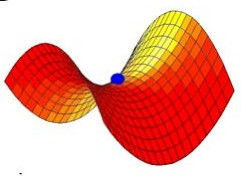Mikrowelt: Bose-Einstein-Kondensat/Photonenstatistik
Particle Traps

An essential part of our knowledge about the atomic structure results from the observation of radiation that is emitted or absorbed by matter - i.e. from spectroscopy. A dream cherished for long among physicists, spectroscopy with a single atom, started to become reality along with the development of trapping techniques since the 1950th.
The figure shows the saddle-type field structure of the Paul trap which may keep a single particle captured.
Since these techniques are available, the high precision of measurements in the atomic range contributed in the rise of completely new research fields. By means of the Paul trap, for example, it should be possible to realize a single-atom clock with thousendfold precision as compared with present-day atomic clocks. The ring trap, a 'scion' of the Paul trap, is used today mainly for fundamental studies into the quantum computer, in a modified form also for investigations of the non-classical light of a single-ion laser. Using the Ioffe-Pritchard trap, Bose-Einstein condensates may be produced.
[ Sitemap ]
[ info ] This website was created by the MPI for the History of Science.
 Scene
Scene


 1st Slide
1st Slide
 Branching Point
Branching Point
 Module: Mikrowelt: Bose-Einstein-Kondensat/Photonenstatistik
Module: Mikrowelt: Bose-Einstein-Kondensat/Photonenstatistik Sequence: lev0_start
Sequence: lev0_start Branching Point: Particles and Light under Control
Branching Point: Particles and Light under Control Slide: Functional Principle of the Paul Trap
Slide: Functional Principle of the Paul Trap

 Paul Trap
Paul Trap